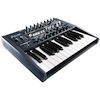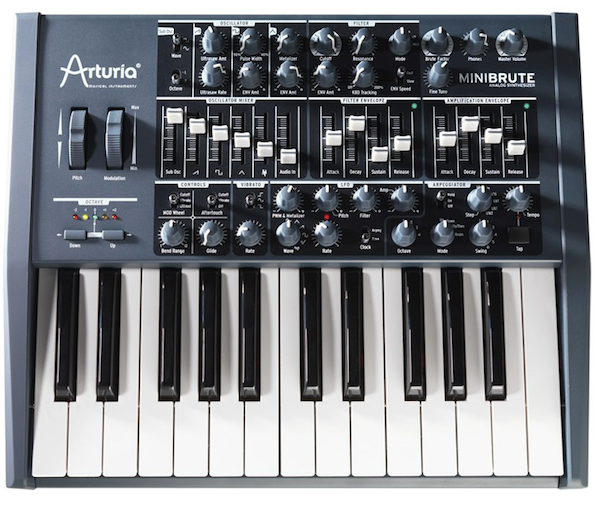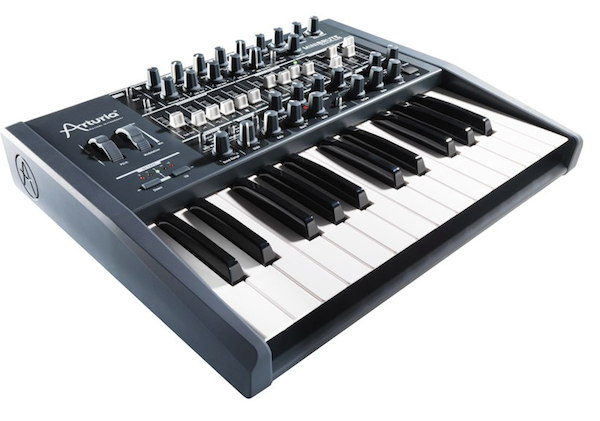ARTURIA MINIBRUTE REVIEW
Posted on Mon 04 March 2013 in entries
 You can read more reviews like this, listen to Tony’s productions, purchase synth patches and more at his personal site -> Tony Long Music.
You can read more reviews like this, listen to Tony’s productions, purchase synth patches and more at his personal site -> Tony Long Music.
I am always excited when a new new analogue synth enters the market. This one, the Arturia MiniBrute, seems to have been a long time coming since it was first announced, although this may be to do with the fact that Arturia have not released an analogue product in the past, so this is a new venture for them. I am hoping it will have all the grit and guts that the controls seem to hint at!
I like Arturia products and my favourite is the hybrid hardware/software drum machine, the Spark. Just like the Spark, everyone seems to be saying that the MiniBrute is a very high quality product with an exceptional price-performance ratio without any great sacrifices. Well, the price does seem very reasonable but let's get it out of the box and see what it can do!
ARTURIA MINIBRUTE - OUT OF THE BOX AND CONNECTED UP
The MiniBrute is packaged well in its bright orange box and comes complete with a power supply, a manual, 10 preset sheets and 5 blank sheets that overlay the controls. As you take it out of the box, it is strange because although it is small, it has an unusually large depth, making it almost square-shaped! It also feels surprisingly solid and you can tell that it is well made. The MiniBrute's size is 325 x 390 x70 mm/12.79 x 15.35 x 2.76 inches and it weighs 4 kg/8.8 lbs. It reminds me of the Roland SH-101 in some ways, but with a load more knobs to tweak and manipulate the sound with.
I thought it would be quick to set up and I was eager to plug it in and play, but Arturia advise that you should switch it on and leave it five to ten minutes for the circuitry to warm up. Well, that gives me time to make a cup of tea and more! I have to admit that I was far too eager though and immediately tried to play it, but it didn't do anything! I suppose at the end of the day you have to appreciate that the MiniBrute is an analogue piece of kit. At least once it had warmed up nicely it stayed in tune. If it is not in tune after your cup of tea, you will need an external tuner to check it. If necessary you can then fine tune it with the 'Fine Tune' knob. The warm up time is apparently dependant on the external temperature.
Well, before I get into what it sounds like, perhaps the biggest surprise for me was just how good the action is on this two-octave monophonic keyboard. In fact I would go so far as to say, I think it is the best action I have found on a keyboard of this size. I am sure not everyone will agree with me, but I found it to be light and fast with just the right amount of return. It is a great shame in some respects that this keyboard is only two octaves. Hopefully Arturia will consider larger versions at some point and have a 'MightyBrute', which I am sure would be great as a solo instrument.
 ](https://www.absolutemusic.co.uk/arturia-minibrute-analogue-monophonic-synthesizer.html)
](https://www.absolutemusic.co.uk/arturia-minibrute-analogue-monophonic-synthesizer.html)
ARTURIA MINIBRUTE - CONTROLS AND LAYOUT
Before we look at the layout, let's consider what the MiniBrute is. It is a 100% analogue monophonic synth that features a single voltage controlled oscillator with a sub-oscillator and multiple waves. The MiniBrute has also got a very interesting voltage controlled multi-mode filter, two envelopes (one for amplitude and the other for the filter), an arpeggiator and Control Voltage In and Outs, so it is able to send and receive MIDI as well as control voltage and gate signals. This is great if you have other analogue equipment. I looked, but it does not have a Ring Modulator.
The panel, in its solid metal and heavy blue-grey case, has a series of knobs, switches and faders. These are all fairly solid, although I found a little bit of play in them; nothing to worry about though. The panel is laid out very logically above the two octave keyboard, which also has after touch. To the left are the modulation and pitch wheels and under these are the octave up and down buttons with a range from -2 to +2.
The MiniBrute essentially has three rows of controls. Row 1 has 15 knobs and 3 switches. Row 2 has 14 faders and row 3 has 14 knobs, 5 switches and 1 button. That is quite a bit of control!
Looking at row 1 in detail, it has three sections - the Oscillator section, the Filter section and some global controls. The Oscillator section has sub oscillator switches and you can choose between square or sine waveshapes. There is also an octave switch to choose between minus 1 or minus 2 octaves. There are then 6 knobs to control the MiniBrute's three basic waveforms: sawtooth, pulse and triangle and the sound is further modified with its signal enhancers: Ultrasaw, Pulse Width Modulation and Metalizer.
The Filter section has five knobs for Cutoff, Resonance, Mode, Envelope Mode and Keyboard Tracking. There is also an Envelope Speed switch for 'Fast' or 'Slow'. The mode is probably the most important control here as the selection alters the oscillator's timbre. You can select from High Pass, Band Pass, Low Pass or Notch. I like the Low Pass the best. Then again, I just love filter sections because there is always a lot of fun to be had!
Interestingly, rather than make their own, Arturia decided to employ a Steiner-Parker design for their filter. I think that this is what really makes this synth different from the rest. It is an unusual choice but you can't help but like it and you soon appreciate just how versatile it is.
The last part of row 1 gives you some global controls. Although the Filter section is not Arturia's, they wanted to have something to call their own to manipulate the sound further and in this section the first knob dial adds further nastiness in something they call the "Brute Factor". Next to this are the headphone, master volume and fine tune controls.
Row 2 has the Oscillator Mixer section directly under the Oscillator control knobs in row 1. Here you can mix in the three waves, add noise, introduce the level of the Sub Oscillator and if you want, control the level of any input audio. These mixed signals then feed the Filter and the Amplifier sections with dedicated ADSR envelope sliders.
Row 3 has four sections called 'Controls', 'Vibrato', 'LFO' and 'Arpeggiator'. The Controls section is quite small but it is divided into four parts. Firstly there is the Mod Wheel three-way switch, which controls the modulation wheel assignment. I love this because you can quickly and easily make your selection for it to control either the filter cutoff frequency, the vibrato or the amount of the current LFO signal that goes to the Pulse Width Modulator, Metalizer, Pitch, Filter and Amp - excellent.
Next are the aftertouch assignments, which are just as good as the modulation wheel options. You can select from three options as to how your aftertouch works. It can be set to control the filter cutoff frequency, vibrato or it can be disabled in the 'Off' position. Below the Mod Wheel and Aftertouch assignments are knobs for Bend Range and Glide.
 ](https://www.absolutemusic.co.uk/arturia-minibrute-analogue-monophonic-synthesizer.html)
](https://www.absolutemusic.co.uk/arturia-minibrute-analogue-monophonic-synthesizer.html)
The next section is even smaller with just two controls relating to Vibrato. It has a tree-way switch from which you can select either a positive square wave to give you a trill-up effect, a sine wave for the classical vibrato effect or a negative square wave for a trill-down effect. There is also a Rate knob that controls the Vibrato's modulation rate ranging from 3 to 30 Hz.
The LFO section of the MiniBrute gives you several modulation waveforms and you can select from sine, triangle, sawtooth, square, random stepped and random gliding. The other controls in this section are Rate, Clock, Pitch, Filter, Amp, Pulse Width Modulator and Metalizer. Indeed, there is quite a bit of modulation available on the MiniBrute. To be honest it is awesome, as you not only have the main programmable LFO but a dedicated Ultrasaw LFO and an LFO dedicated to vibrato effects.
The last section is the Arpeggiator, which has a good selection of controls. It starts with a simple switch for Hold, On or Off. You can then decide on the tempo subdivisions that you want to use. The selection dial has options for quarter notes, eighth notes, sixteenth notes, quarter note triplets, eighth note triplet and sixteenth note triplets. Other controls allow you to add swing, choose the arpeggiation range from one to four octaves, change the tempo or use the Tap button, or use the mode knob to change the playing order of the notes by selecting either: 'Up', 'Down', 'Up and Down' or 'Random'. You can also transmit your arpeggio lines via the CV/gate.
ARTURIA MINIBRUTE - CONNECTIONS
You cannot complain about the amount of connections on such a small synth. On the MIDI side of things, I expected a five-pin DIN MIDI In, but I was very surprised to also see the inclusion of a MIDI Out, which means you could use your MiniBrute as polyphonic MIDI controller. There is also a USB port that allows you to connect to the software (more on this in a bit).
Next up you have balanced quarter-inch audio In and Out connections, a Headphone output, a Gate Source switch and six 3.5 mm CV Control sockets for Pitch Out, Gate Out, Gate In, Amp, Filter and Pitch.
 ](https://www.absolutemusic.co.uk/arturia-minibrute-analogue-monophonic-synthesizer.html)
](https://www.absolutemusic.co.uk/arturia-minibrute-analogue-monophonic-synthesizer.html)
ARTURIA MINIBRUTE - SOUND, FX AND SOUND CREATION
I think that the only way to describe the MiniBrute is by saying that it is aggressive! You need to tame the beast to get it to produce softer sounds. It seems to love rich and sometimes metallic distortion and demands that this is what it is going to give you. There are no presets, no LCD and therefore no menus to go through. There are some excellent preset templates that lay over the controls, which can provide you with a start to sound design and there are also some blanks so that you can make your own.
I like the raw sounds that it produces from its rich oscillator waveforms and excellent filter. By the time you add the Brute Factor, the aggression really kicks in. It is difficult to explain just what the MiniBrute actually sounds like - you really should try one out. It is great for creating lead and bass sounds and the use of the arpeggiator gives the obvious feeling that a lot more is going on.
You can also create some fantastic effects with the MiniBrute and you can even play just the Resonance by itself. As you use the MiniBrute, you get to realise that the Mixer section is directly related to the Filter Section. If you want to create some different sounds, you don't need to have the mixer controls up high. If you do it will overdrive the filters, which may be ok for certain aggressive sounds, but I would start with the mixer controls quite low and bring them up gradually, experimenting with what you like the sound of and then adjust the filter resonance controls etc. Keeping the controls of the MiniBrute low gives you a cleaner sound and you can slowly introduce some harmonics. You could then bring in the sub oscillator to give some depth to the sound. You may also want to try again with the mixer controls down and start to bring up the Brute Factor and then adjust the Filter controls. This is not to say that you should ignore the other controls like the LFO, Vibrato, Metalizer etc. though. This is just a starting point for your experimentation - it is all great fun and educational.
I did my experimenting and produced some great speaker-shaking bass sounds as well as some hard-edged effects. My results were not instant and you really do have to spend some time getting used to its capabilities. Occasionally, you can be very lucky and something awesome hits you quite quickly. You have to be very careful if you are using headphones when doing this though, so be warned!
I also liked the use of the Ultrasaw as this adds two additional out-of-phase sawtooth waveforms and gives a type of chorus-thickening. If you push it you can get some of those great wobble effects.
ARTURIA MINIBRUTE - SOFTWARE
I did not get the opportunity to test the software but I understand that there are simply two pages to it. The first page is for configuration of the MiniBrute and provides you with options to select a MIDI channel. Although I was very happy with my keyboard action, the software gives you access to three velocity and three aftertouch curves. It will also allow you to adjust LFO key-retriggering on/off, the audio gate threshold, the key trigger mode, legato on/off and the arpeggiator hold type. The second page is for firmware updates.
http://www.youtube.com/watch?v=LlN1_LajMrE
ARTURIA MINIBRUTE - CONCLUSION
Well, personally I think that the Arturia MiniBrute is greater than the sum of its parts. You really do get a lot for your money here. I found it to be extremely well made, great fun, very versatile, flexible and it sounds powerful. The MiniBrute has its own unique punchy sound and it seems to want to stand out, but sometimes you will love it and other times you may find it too much. If you consider that this small unit has a multimode arpeggiator, a wealth of connections, a great keyboard action, aftertouch, it is velocity-sensitive and has a multimode Steiner-Parker filter, as well as so many other features, it certainly worries the competition.
I would not say that the MiniBrute is for everyone but if you're after something analogue and aggressive, this is what you want! It will fit in perfectly with an existing analogue synth set-up due to its unique sound, or it would make a great first analogue synth due to its tweakability and fantastic price. It also has sufficient extras that should keep you interested for quite some time.
For more information on the Arturia MiniBrute, click the link below or give us a call on 01202 597180.
Arturia MiniBrute - More Info/Buy
******If you're interested in buying and you have seen it cheaper elsewhere, please call us or use our
As well as receiving our first rate customer service you can also claim money off your next purchase with our loyalty points scheme and receive a 3 year warranty if you sign up to our FREE VIP Club (click here for more infomation). Many of our items also come out on a FREE next-day delivery service to mainland UK customers, so you won't be left waiting!
Also, if you want to keep up with all our latest offers, competitions, news and videos, why not follow us on Facebook and Twitter?
